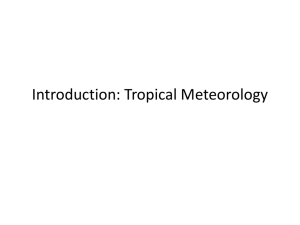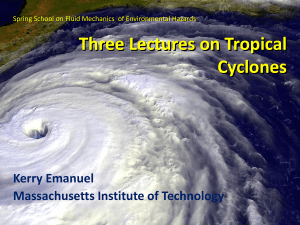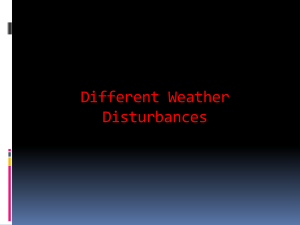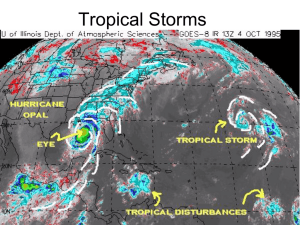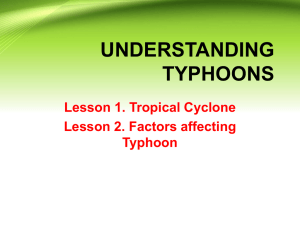Introduction: Tropical Meteorology
advertisement
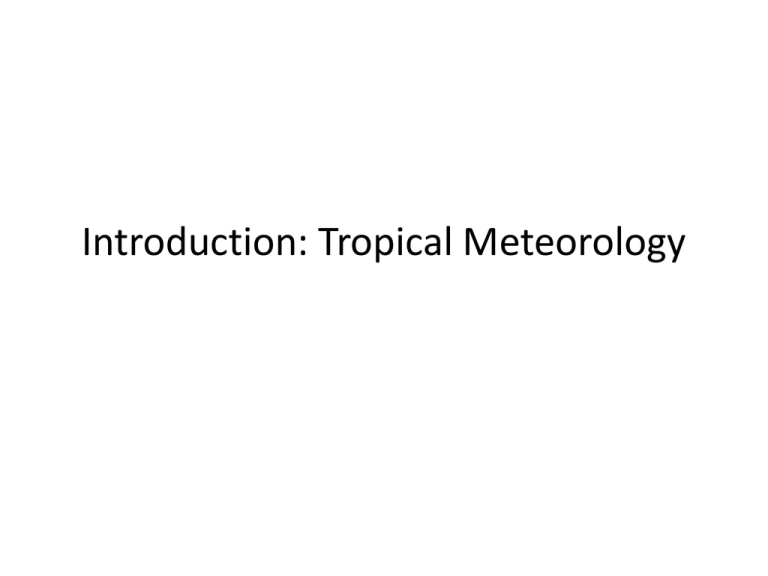
Introduction: Tropical Meteorology For Further Reading Please read over Chapter 1 of: “Introduction to Tropical Meteorology,” 2nd Edition http://www.meted.ucar.edu/tropical/textbook_2nd_edition/print_1.htm (Free COMET/MetEd account required.) This material will prove useful as we move into in-depth discussions of aspects of tropical climatology and circulations later this week and into next week. General Definition of the Tropics “…the latitudes at which the Coriolis force, horizontal temperature gradients, and horizontal pressure gradients are all relatively weak…” • Why might these all be weak in the tropics? • What implications do they have upon the climatology of the tropics? Specific Definitions of the Tropics “The range of latitudes where the sun can be directly overhead at any point during the year.” (Figure obtained from Introduction to Tropical Meteorology, 2nd Edition, © 2011 COMET.) Specific Definitions of the Tropics “The range of latitudes where the net annual incoming solar radiation is greater than the net annual outgoing terrestrial radiation. ” (Figure obtained from Introduction to Tropical Meteorology, 2nd Edition, © 2011 COMET.) Discussion Question #1 Assume that incoming solar radiation is at a maximum at the equator and decreases to the north and south… • What is the meridional temperature distribution that results from this situation? • Assuming that this temperature distribution holds throughout the troposphere, from thickness arguments, what is the resulting meridional distribution of surface pressure? • Where might one expect rising motion under such conditions? Specific Definitions of the Tropics “The region of net ascent, easterly boundary layer flow, and lower surface pressures associated with a meridional circulation centered near the Equator.” (Figure obtained from Introduction to Tropical Meteorology, 2nd Edition, © 2011 COMET.) Specific Definitions of the Tropics “The range of latitudes where the diurnal temperature range is greater than the range between the highest and lowest annual high temperature…” (Figures obtained from Introduction to Tropical Meteorology, 2nd Edition, © 2011 COMET.) Meteorology of the Tropics climatology of the tropics radiative-convective equilibrium tropical meridional and zonal circulations El Nino Southern Oscillation subtropical ridges and the trade wind inversion equatorial waves and oscillatory modes monsoons tropical disturbances and jets Tropical Cyclone Meteorology tropical cyclone formation tropical cyclone climatology interseasonal and intraseasonal variability mature tropical cyclone structure tropical cyclone intensity change extratropical and tropical transition tropical cyclones and climate change tropical cyclone motion tropical cyclone monitoring and forecasting
